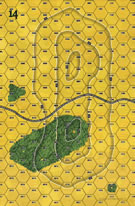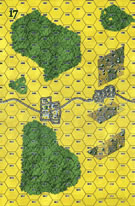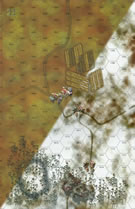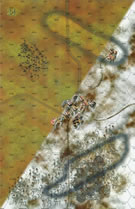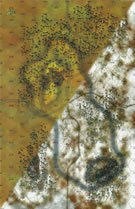|
Slim Pickings Patton's Nightmare #7 |
||
|---|---|---|
| (Attacker) United States | vs | Soviet Union (Defender) |
| Formations Involved | ||
|---|---|---|
| Soviet Union |  |
Army (RKKA) |
| United States |  |
10th "Tiger" Armored Division |
| United States |  |
12th "Hellcat" Armored Division |

| Total | |
|---|---|
| Side 1 | 0 |
| Draw | 0 |
| Side 2 | 0 |
| Overall Rating, 0 votes |
|---|
|
0
|
| Scenario Rank: of |
| Parent Game | Patton's Nightmare |
|---|---|
| Historicity | Alt-History |
| Date | 1947-08-28 |
| Start Time | 11:00 |
| Turn Count | 24 |
| Visibility | Day |
| Counters | 242 |
| Net Morale | 0 |
| Net Initiative | 0 |
| Maps | 6: 14, 17, 22, 23, 24, 25 |
| Layout Dimensions | 86 x 84 cm 34 x 33 in |
| Play Bounty | 288 |
| AAR Bounty | 227 |
| Total Plays | 0 |
| Total AARs | 0 |
| Battle Types |
|---|
| Exit the Battle Area |
| Inflict Enemy Casualties |
| Road Control |
| Urban Assault |
| Conditions |
|---|
| Entrenchments |
| Hidden Units |
| Minefields |
| Off-board Artillery |
| Randomly-drawn Aircraft |
| Reinforcements |
| Smoke |
| Scenario Requirements & Playability | |
|---|---|
| Elsenborn Ridge | Maps + Counters |
| Patton's Nightmare | Base Game |
| Road to Berlin | Maps + Counters |
| Introduction |
|---|
|
The 10th and 12th Armored Divisions were getting a little threadbare between combat losses, mechanical breakdowns, and nearly 36 hours of continuous combat. Also, the flood of new Soviet units seemed unabated and the quality of their fighting skills was nothing to sneeze at. Nevertheless, the XXI Corps Commander knew it was too early to commit his reserve armored division the "Liberators" of the 20th. So he gathered his brigade and division commanders together and worked quickly to cobble together another thrust with the slim pickings of available units. Meanwhile, his new opponent, the 12th Guards Rifle Corps was setting up a little surprise for the Ameriganskis. |
| Conclusion |
|---|
|
A classic combined arms offense squares off against a combined arms defense. The American player must focus the attack to maximize the offensive punch that can be brought to bear, then quickly exploit the early successes. The sly Soviet player will use the hidden forces and terrain to set up kill boxes for the American to enter and get bogged down in, picking off the attackers when he can, and falling back to set up another defense. The Soviet can afford to trade space for time and enemy casualties, and commit his reserve wisely. |
| AFV Rules Pertaining to this Scenario's Order of Battle |
|---|
|
| 4 Errata Items | |
|---|---|

|
These units should have a Direct Fire rating of 2-3, just like the RKKA and NKVD counterparts. (danradz
on 2011 May 04)
|

|
All Guards JS-IIs should have AT fire values of 8-8. (Shad
on 2010 Dec 15)
|

|
All Guards T-34/85 tanks should have AT fire values of 7-7. (Shad
on 2010 Dec 15)
|

|
The M18 has a special rule in Battle of the Bulge but it applies globally: "A two-step M18 unit can fire one anti-tank shot and move half its movement allowance (retain fractions) in a single impulse. The order in which it does these two actions is the player's choice." (Shad
on 2010 Dec 15)
|

 PaNi006
PaNi006 



